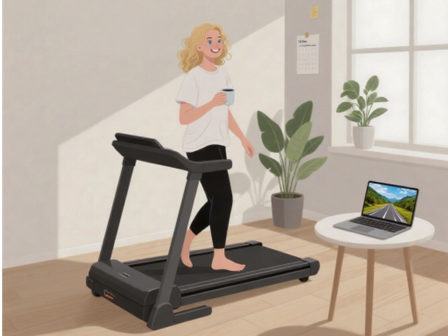When the Fireworks Fizzle and Reality Sneaks Back In
Amanda Lin, a 35-year-old UX designer living in San Francisco, had just wrapped up a rare and relaxing Fourth of July week with her family in Michigan. She’d taken a full seven days off—July 1st through 7th—to escape deadlines, Slack pings, and the pace of the city. It was her longest break since the start of the year.
The trip was exactly what she had hoped for. Warm evenings on the deck. Fireworks that lit up the lake. Wine glasses clinking in the kitchen. She spent her days lounging in old t-shirts, eating grilled corn and blueberry pie, and laughing so hard her cheeks hurt.

“I never even opened my suitcase with my workout gear,” Amanda admitted. “And honestly? I didn’t miss it at the time.”
She didn’t feel guilty. Not while watching the fireworks. Not when skipping her usual morning walk. But by the time she returned to her San Francisco apartment on the 8th, something felt... off.
Before the Break: A Gentle, Doable Routine
Amanda never considered herself a fitness fanatic. But she did have a rhythm—one that worked for her life.
Each weekday morning, she spent 10 to 15 minutes walking on her foldable treadmill while catching up on news, reading Slack threads, or listening to podcasts. It was her daily warm-up—not for her body, necessarily, but for her brain.
The rest of the day, she found little chances to move. A few stretches after lunch. A quick burst of movement before her 3 p.m. client call. A relaxing walk while streaming a show in the evening.
Her workouts didn’t look like workouts. And that was the point.
“I wasn’t trying to sculpt anything,” she said. “I just wanted to feel like I was inside my own body.”
But routines are fragile. And after a week of staying up late and doing absolutely nothing physical, Amanda could feel hers had slipped away.
After the Vacation: Subtle Signs She'd Slipped
The first day back was rough. Not because work was overwhelming, but because Amanda felt misaligned. Her concentration cracked easily. Her appetite was strange—too much one hour, then none the next. Sleep, once predictable, turned restless.
Even emotionally, something had shifted. She wasn’t upset. She just felt slow.
“I could tell my body was confused,” she said. “Like I’d unplugged too long and didn’t know how to reconnect.”
She spotted her treadmill—the Yesoul T1M Plus, folded quietly under her bookshelf. It was almost like it was waiting. But Amanda wasn’t ready. Not quite yet.
The next day? Same.
It wasn’t that she didn’t want to move. She just didn’t know where to start. Or how to want to.

A Nudge, Not a Plan
By midweek, something changed.
Amanda stumbled upon a short video on YouTube titled “5-Minute Walk to Clear Your Mind.” The title didn’t promise transformation. It didn’t mention weight loss or discipline. Just walking. Just five minutes.
She didn’t overthink it.
She grabbed her phone, plugged it into the treadmill with a regular data cable, mirrored the video to the built-in screen, and stepped on.
“I told myself I could stop halfway through,” she said. “But once I started, I didn’t want to.”
The instructor’s voice was calm. The pace was slow. Amanda walked in socks. Her windows were open. For five minutes, there was nothing but motion and breath.
It felt like turning the volume down on a noisy room.
A Machine That Didn’t Demand
Amanda didn’t need a high-tech fitness studio in her living room. What helped was how simple her treadmill was to use.
She’d chosen the Yesoul T1M Plus a few months earlier. It was compact, foldable, quiet. It fit into her space—and more importantly, into her life.
What Amanda appreciated most? She didn’t need a subscription or Yesoul account to use the treadmill’s screen. She simply connected her phone with a standard data cable, mirrored whatever she wanted to watch—workout videos, YouTube, Netflix—and started walking. No extra steps. No hidden costs.
“Some days I cast a workout,” she said. “Other days, I just watch a Netflix episode while walking. Either way, I’m moving.”
And somehow, that felt like enough.

T1M Plus treadmill
One Small Win Led to Another
The next morning, Amanda did it again.
Not because she planned to—but because she wanted to.
Ten minutes this time. A low-impact dance warm-up she found randomly. She giggled halfway through. It felt silly and joyful.
By Friday, she had walked every day that week. Not long, not intensely. But consistently.
That weekend, she even folded laundry while walking. Not graceful—but surprisingly efficient.
“I realized I didn’t have to wait for motivation,” Amanda said. “Just action. Even small action.”
Signs She Was Returning
After about a week, Amanda started noticing things.
Her focus during video calls sharpened.
Her sleep deepened—less tossing, fewer dreams.
Her food cravings evened out.
Her posture improved.
Her energy started rising, not crashing.
“I didn’t even realize it at first,” she said. “I just noticed I was laughing more. Getting less annoyed.”
The changes weren’t dramatic. But they were honest.

Making Space, Literally
Amanda loved that the T1M Plus folded completely flat and could be rolled under her standing desk or bookshelf. It made using it feel light—something that didn’t take over her home or mind.
It was easy to unfold. Easy to fold back. Never in the way.
“It was like having a walking partner who didn’t talk unless I wanted it to,” she joked.
Even when guests visited, she could tuck it away in seconds.
Redefining What Counts
Amanda used to think that if she wasn’t sweating, it didn’t count.
Now? A walk to her favorite playlist counts. A stroll while watching recipe videos counts. Even standing on the treadmill barefoot and swaying through a stretching video—yep, that counts too.
“I’ve let go of the idea that exercise needs to look a certain way,” she said. “What matters is that I show up for myself.”
And she does. Not every day. But more days than not.


Amanda is walking on the T1M Plus treadmill using the scanning feature
The Inner Dialogue Is Softer Now
“I used to beat myself up for falling out of routine,” Amanda said. “Now I just ask: How do I feel today? And what movement would support that?”
Some days, it’s a jog. Some days, it’s just standing and stretching. Some days, nothing at all. But she knows she can begin again, any time.
That knowing? It’s changed everything.
Advice for Anyone Coming Back After a Holiday
Amanda knows the Fourth of July—and holidays in general—can throw people off. The food, the sleep schedule, the sudden stillness. It’s easy to feel disconnected afterward.
Her advice?
Don’t overcompensate. You don’t need a plan. You need a moment.
Keep it frictionless. If movement is easy to start, you’ll do it more.
Pair it with something enjoyable. A show, a breeze, music, even iced coffee.
Be patient. You didn’t lose anything. You’re just resetting.
“Start small,” she said. “Then start again. And again. That’s how it works.”
Movement as Homecoming
Amanda didn’t bounce back.
She returned—slowly, intentionally.
Her treadmill, that quiet little machine folded against the wall, helped her reconnect not to a version of herself from the past—but to the one that simply needed to feel grounded now.
“It’s not about catching up,” she said. “It’s about moving forward with softness.”






Leave a comment
All comments are moderated before being published.
This site is protected by hCaptcha and the hCaptcha Privacy Policy and Terms of Service apply.